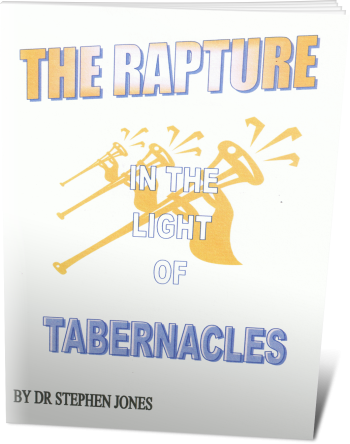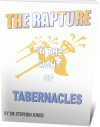Latest Posts
View the latest posts in an easy-to-read list format, with filtering options.

The resurrection is the fulfillment of the Feast of Trumpets, and the "catching away" of the saints is the fulfillment of the Feast of Tabernacles. Since most teaching on the "Rapture" does not take the Biblical feast days into account, this is a very valuable and different study.
Category - General

The instructions for the Feast of Tabernacles in Lev. 23 single out only two days—the first and the eighth—as Sabbaths. However, when we look deeper at the types and shadows, a third day begins to emerge from its hiding place. It appears to be the fifth day of Tabernacles, representing "the midst of the feast."
First of all, I believe that the eight trips that Moses made up Mount Sinai represent the eight days of Tabernacles. At the end of his final trip, he returned with his face glowing, holding the new tablets of the law (Ex. 34:29). I believe that this final return came to be celebrated as the eighth day of Tabernacles.
Trip 3: Ex. 19:20 to Ex. 19:25
Trip 5: Ex. 24:9 when the 70 elders met with God. No return mentioned, but implied.
Trip 6: Ex. 24:15 to Ex. 32:15.
Trip 7: Ex. 32:31 to Ex. 32:34
Trip 8: Ex. 34:4 to Ex. 34:29 when Moses' face was glorified.
I showed earlier the purpose of the eighth day. It is to present the Sons of God to the Father and circumcise their hearts, making them sinless. It also comes at the end of their week of cleansing from death (mortality), as well as the week of priestly consecration.
Yet take note that the fifth trip up the mount included the seventy elders, "and they saw the God of Israel" (Ex. 24:10). I believe this to be a very prophetic statement in light of the New Testament types of Tabernacles.
The Gospel of John gives us the most indepth insights about the Feast of Tabernacles of any of the N.T. Gospels. There are eight miracle-signs [Gr. semeion in John 2:11] in John's Gospel, which speak of the eight days of Tabernacles in the same manner as Moses' eight trips up the Mount. They are as follows:
Sign 1: John 2:1-10 (Marriage feast of Cana, turning water to wine)
Sign 2: John 4:46-54 (the Nobleman healed)
Sign 3: John 5:1-13 (the Bethesda healing)
Sign 4: John 6:1-13 (Feeding the 5,000)
Sign 5: John 6:16-25 (Walking on the water, Jesus comes to the disciples)
Sign 6: John 9:1-7 (the Blind Man healed)
Sign 7: John 11:1-45 (Lazarus raised from the dead)
Sign 8: John 21:3-12 (the 153 large fish caught)
As you can see, the fifth sign in John shows Jesus coming to the disciples in the middle of the sea of Galilee, with Peter going out to meet Him. It is comparable to Moses' fifth trip, where the seventy elders went up to meet the Lord and "saw the God of Israel."
John structures his Gospel in a unique way. First comes the sign, then the reaction of the people, followed by specific teachings of Jesus that help us to understand that sign. The fourth and fifth signs, however, are an exception to the general rule, because they appear back-to-back, with reaction and commentary coming only after both signs are complete. It is as if John wanted to draw attention to the middle signs.
Both signs are recorded in the first half of John 6, and only then do we see the reaction of the nay-sayers. Then in the rest of John 6 is commentary on the fourth sign. John 7, the story of how Jesus kept Tabernacles, is actually the commentary on the fifth sign. You will have to read John 6 and 7 for yourself to get a clear picture of the sequence of events and how they relate to the Feast of Tabernacles.
As I said, the story in John 7 is the story illustrating the fifth sign where Jesus came to the disciples in the middle of the sea of Galilee, and Peter went out to meet Him (Matt. 14:29). Look at the similarities.
In John 6, Jesus told the disciples to go out ahead of him across the lake into the storm (tribulation). Then He came to them after they had gone 25 or 30 furlongs (6:19), which was the middle of the lake. When Jesus got into the boat, the entire boat was transported to Capernaum (6:21, 24). Capernaum means "the Covering of the Comforter." It speaks of the fullness of the Spirit.
In the same manner, in John 7, Jesus told His disciples to go to Jerusalem ahead of Him (7:8) to observe the feast of Tabernacles (7:2). Then later Jesus came and manifested Himself in the temple in the middle of the feast (7:14). I relate this also to the prophecy in Mal. 3:1, "And the Lord, whom you seek, will suddenly come to His temple."
Then on the last great day of the feast, Jesus stood up and shouted (7:37, 38),
{John 7:37} 37 If any man is thirsty, let him come to Me and drink. {John 7:38} 38 He who believes in Me, as the Scripture said, from his innermost being shall flow rivers of living water.
This event occurred on the eighth day of Tabernacles. It correlates with the story in John 6, when Jesus took the disciples to Capernaum, "the Covering of the Comforter." The overcomers must be given the fullness of the Spirit in order to return with the glorified body (as per Moses) and begin their work of priestly ministry in the earth, changing clothes at will. The types of both Old and New Testament show this to be the purpose of the eighth day of Tabernacles.
So if we summarize our findings, we see that the Feast of Tabernacles begins by giving birth to the Manchild—that is, giving the overcomers immortality. It also begins a seven-day time of cleansing from touching a dead body, as well as beginning a seven-day consecration to the priesthood for ministry.
Jesus then comes to the overcomers in the middle of the Feast, perhaps on the fifth day. On the Feast of Trumpets over two weeks earlier the dead were raised to meet the Lord; but in the midst of Tabernacles it appears that the living overcomers, represented by Peter, will go out to meet Him.
What? Two "raptures"? Well, there is no biblical statement saying otherwise. Paul gives us the order of events, but does not give us details in 1 Thess. 4:16, 17,
{1 Thessalonians 4:16} 16 . . . the dead in Christ shall rise first. {1 Thessalonians 4:17} 17 Then we which are alive and remain shall be caught up together with them in the clouds to meet the Lord in the air.
So first the dead will be raised, and we will meet Him above ground in the air. The next event will be the catching away of those who are "alive and remain." This is not a statement that establishes timing. It only establishes the order of events. Paul's only statement about timing comes earlier in verse 15, saying that we who are alive will not precede those who have already died.
The blowing of the trumpet at the Feast of Trumpets signifies a gathering of leaders in a resurrection from the dead. But the prophetic type in Moses and Jesus show us that Jesus comes to the living overcomers in the midst of Tabernacles, with Peter going out to meet Him.
Further, if there is to be a seven-year time of tribulation, then it is represented by the storm on Galilee. Keep in mind, then, that Jesus came in the middle of the lake, not at the beginning or at the end. Could that speak of a "mid-trib" position? While I do not necessarily believe in a seven-year tribulation period, I do believe that Christ will come (to those who are alive) in the middle of the Feast of Tabernacles some year. Yet in another sense, He will also come weeks earlier at the Feast of Trumpets to raise the dead.
For this reason it is important to understand the feast days. They are "appointed times" in prophecy, and though types and signs are meant to hide as well as to reveal, there is a certain amount of information that is clearly revealed. There will always be some obscurity, of course, and so we should be careful not to be over-confident that we are correct in understanding the types that prophesy of future things.